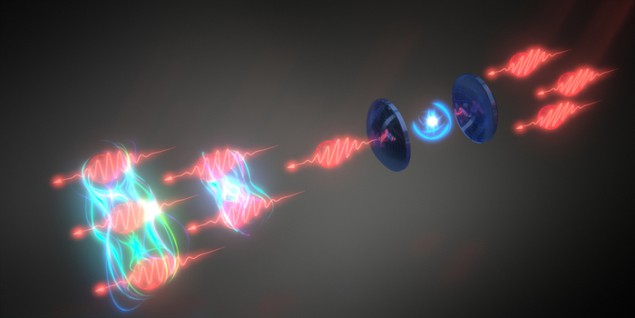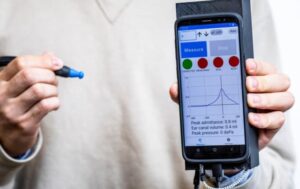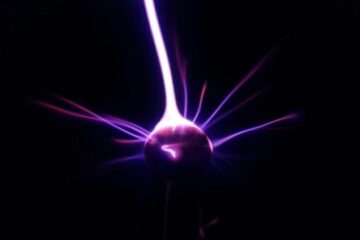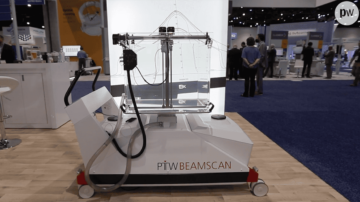
Researchers have succeeded in observing individual photons and a pair of bound photons interacting with a single quantum dot in a different way. The feat could pave the way to the manipulation of exotic photonic states with implications for quantum-enhanced measurement techniques, light-based quantum computing and metrology.
One of the characteristics of photons is that they do not easily interact with one another. This property allows for near-distortion-free transfer of information at light speed for long-distance communications in optical fibres. In some instances, however, researchers want light to interact. In interferometers, for example, they want to generate states of light that can make these instruments more sensitive. This requires some interaction between the photons.
The interacting photons form bound states, quasiparticles that give rise to technologically important physical processes like stimulated emission (lasing). Until now, however, such states had never been observed directly.
Inducing strong photon interactions
In the new work, researchers led by physicists Sahand Mahmoodian of the University of Sydney in Australia and Natasha Tomm from the University of Basel in Switzerland observed these states by guiding pulses of very dim laser light (that is containing a low number of photons) via a circulator into a quantum-dot cavity system. The light is backscattered and redirected by the circulator towards a so-called Hanbury Brown-Twiss set-up equipped with single photon detectors that record the moment at which individual photons hit them.
The pulses can be approximated as having zero, one or two photons in them, explains Mahmoodian, but the probability of having one photon is much larger than two photons. “When we measure the intensity of the pulse packet, that measurement is dominated by the one-photon part of the pulse because the two-photon part is much smaller in magnitude. We overcome this problem by measuring the so-called second-order correlation function of light, which allows us to measure the likelihood of two photons arriving within a very short time difference at the detectors.”
Two photons delayed less than one photon
The measurement technique, which is detailed in Nature Physics, is insensitive to single photons so it only records the two-photon part of the pulse. By comparing these two measurements, the researchers observed that the two-photon state was delayed less than one-photon state. They were able to see the difference between one photon interacting with their system compared with two because the device that they built induces such strong interactions between the photons. With this very strong photon–photon interaction, the two photons form the two-photon bound state.
“To measure single photons, we measure its time of arrival at just one of the detectors in our setup,” explains Tomm. “To measure the correlation between two photons, we measure the time of arrival of two photons at two different detectors. If there is only one photon, only one of the two detectors ‘clicks’, and the other one not, so the ‘correlation’ between the two detectors is null. This is why this measurement is insensitive to single-photons: we make use of two detectors. If there is only one photon, only one detector clicks.”
“Being able to see one photon and two photons interacting differently with a quantum dot (which behaves essentially like a single artificial atom) basically means we are doing nonlinear optics with just two photons,” adds Mahmoodian. “By demonstrating that we can identify and manipulate such photon bound states, we have taken a vital first step towards harnessing quantum light for practical use,” he tells Physics World.

How indistinguishable are indistinguishable photons? New optical interferometer puts a number on it
According to the researchers, such quantum states of light can in principle be used to make more sensitive measurements with better resolution using fewer photons – something that could be important for applications in biological microscopy, where high-intensity light can damage delicate samples and in which the features being observed are particularly small.
“The platform that we have built is very flexible,” adds Mahmoodian. “It is an almost ideal interface between light and matter at the quantum scale and could be used to generate a variety of different types of quantum light for application in areas like quantum-enhanced communication, metrology or computation.”
For example, such a device could provide a building block for realizing special states of photons that can be used to build “fault-tolerant” quantum computers that are robust to noise, he says. “This is one of our future research directions.”
- SEO Powered Content & PR Distribution. Get Amplified Today.
- PlatoAiStream. Web3 Data Intelligence. Knowledge Amplified. Access Here.
- Minting the Future w Adryenn Ashley. Access Here.
- Source: https://physicsworld.com/a/photon-bound-states-pave-the-way-to-manipulation-of-quantum-light/
- :is
- :not
- :where
- 77
- a
- Able
- Adds
- After
- allows
- an
- and
- Another
- Application
- applications
- ARE
- areas
- arrival
- arriving
- artificial
- artist
- AS
- At
- atom
- Australia
- Basel
- Basically
- BE
- because
- been
- being
- Better
- between
- bind
- Block
- bound
- build
- Building
- built
- but
- by
- CAN
- characteristics
- Communication
- Communications
- compared
- comparing
- computation
- computers
- computing
- Correlation
- could
- Delayed
- demonstrating
- detailed
- device
- difference
- different
- directly
- do
- doing
- DOT
- easily
- emission
- equipped
- essentially
- example
- Exotic
- Explains
- feat
- Features
- First
- flexible
- For
- form
- from
- function
- future
- generate
- GitHub
- Give
- Harnessing
- Have
- having
- he
- Hit
- How
- However
- HTML
- http
- HTTPS
- ideal
- identify
- image
- implications
- important
- in
- individual
- information
- instruments
- interact
- interacting
- interaction
- interactions
- Interface
- into
- issue
- IT
- ITS
- jpg
- just
- just one
- larger
- laser
- Led
- light
- like
- Low
- make
- Manipulation
- Matter
- max-width
- means
- measure
- measurements
- measuring
- Metrology
- Microscopy
- moment
- more
- New
- Noise
- now
- number
- of
- off
- on
- ONE
- only
- optical
- optics
- or
- Other
- our
- Overcome
- part
- particularly
- Photons
- physical
- platform
- plato
- Plato Data Intelligence
- PlatoData
- Practical
- principle
- probability
- Problem
- processes
- property
- provide
- pulse
- Puts
- Quantum
- quantum computers
- quantum computing
- Quantum dot
- realizing
- record
- records
- requires
- research
- researchers
- Resolution
- Rise
- robust
- s
- says
- Scale
- see
- sensitive
- setup
- Short
- single
- small
- smaller
- So
- some
- something
- special
- speed
- State
- States
- Step
- strong
- such
- switzerland
- sydney
- system
- techniques
- tells
- than
- that
- The
- their
- Them
- There.
- These
- they
- this
- thumbnail
- time
- to
- together
- towards
- transfer
- true
- types
- university
- us
- use
- used
- using
- variety
- very
- via
- vital
- was
- Way..
- we
- were
- which
- why
- with
- within
- Wonderland
- Work
- world
- zephyrnet
- zero












